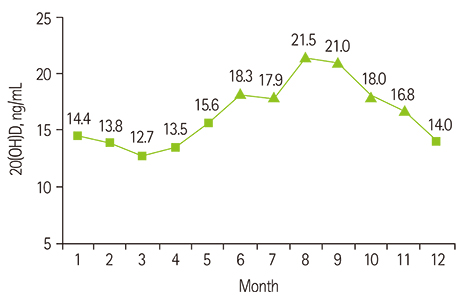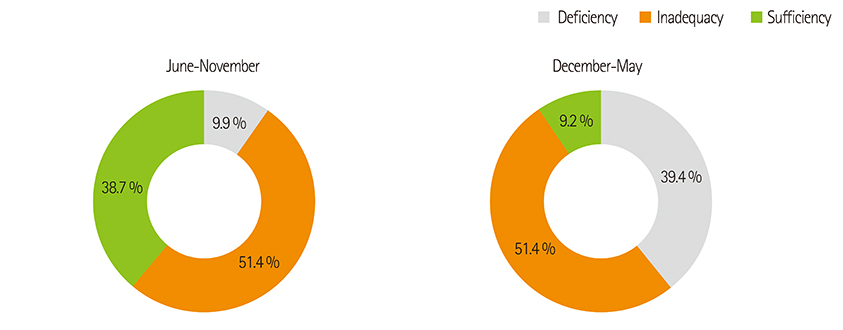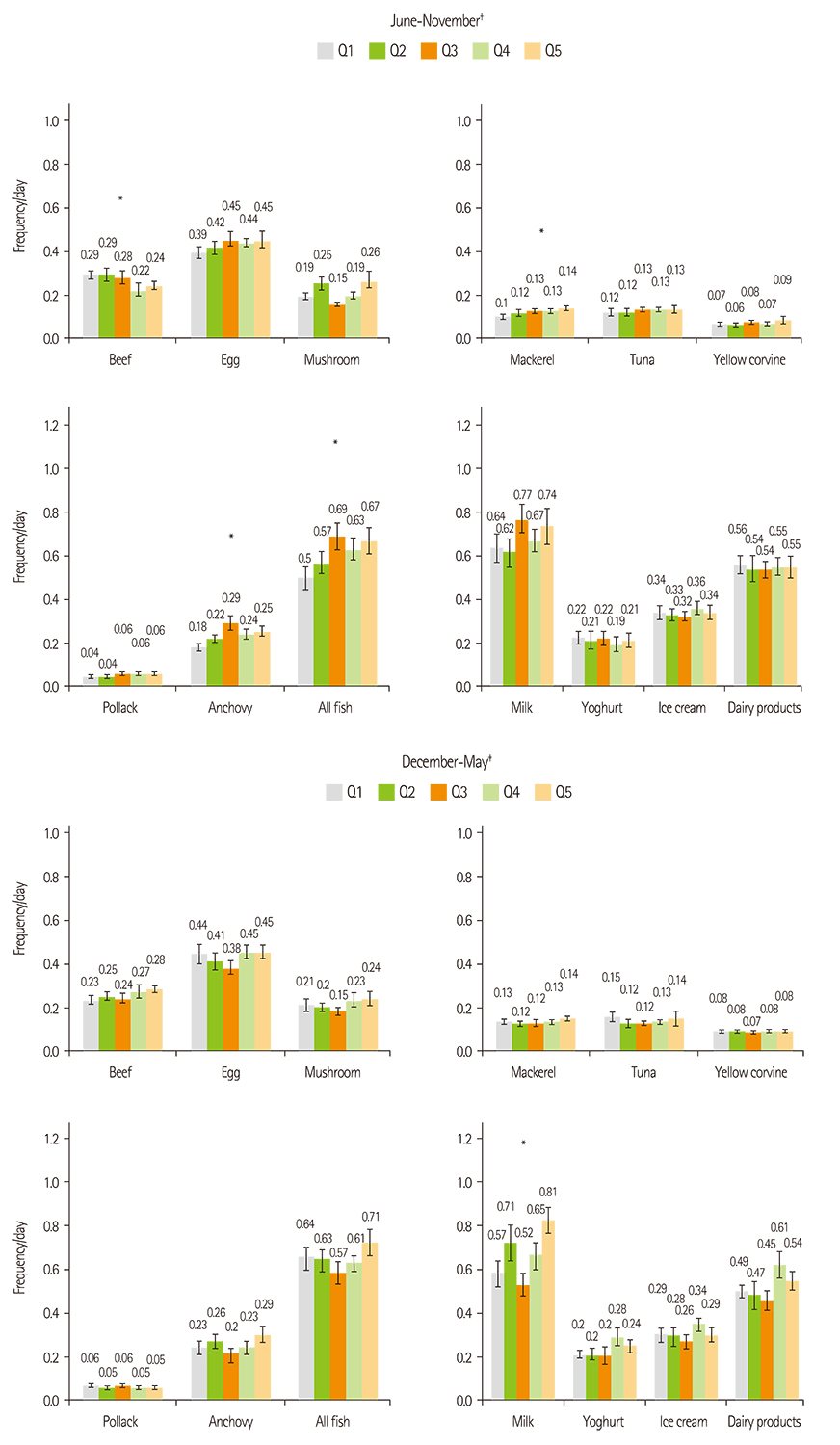Clin Nutr Res.
2013 Jul;2(2):107-114. 10.7762/cnr.2013.2.2.107.
The Association Between Serum 25-Hydroxyvitamin D Concentration and Consumption Frequencies of Vitamin D Food Sources in Korean Adolescents
- Affiliations
-
- 1Department of Clinical Nutrition, Dongduk Women's University, Seoul 136-714, Korea.
- 2Department of Food and Nutrition, Ewha Womans University, Seoul 120-750, Korea.
- 3Department of Food and Nutrition, Kyung Hee University, Seoul 130-701, Korea.
- 4Department of Home Economics Education, Pai Chai University, Daejeon 302-735, Korea.
- 5Department of Food and Nutrition, Dongduk Women's University, Seoul 136-714, Korea. yjyang@dongduk.ac.kr
- KMID: 2279665
- DOI: http://doi.org/10.7762/cnr.2013.2.2.107
Abstract
- The objectives of this study were to investigate the status of vitamin D in Korean adolescents and to determine the association between serum 25-hydroxyvitamin D (25(OH)D) concentration and consumption frequencies of vitamin D food sources by season (June to November and December to May). The subjects were 1,579 adolescents aged 12-18 years participating in the 2008-2009 Korean National Health and Nutrition Examination Survey (KNHANES). Consumption frequencies of vitamin D food sources were estimated by using a qualitative food frequency questionnaire (FFQ). Thirteen food items were selected as vitamin D food sources including beef, egg, mackerel, tuna, yellow corvine, pollack, anchovy, mushroom, milk, yoghurt, ice cream, all fish and dairy products from the FFQ based on previous research. The data was analyzed using proc survey procedures. The deficiency (5.25-12 ng/mL), inadequacy (12-20 ng/mL) and sufficiency (> 20 ng/mL) proportions of serum 25(OH)D from June to November and December to May were 9.9%, 51.4%, 38.7%, and 39.4%, 51.4%, 9.2%, respectively. Mean serum 25(OH)D concentration was positively related to the consumption frequencies of mackerel, anchovy, all fish and milk. These results suggest high proportion (> 61%) of Korean adolescents were vitamin D deficiency or inadequacy, and serum 25(OH)D was associated with the consumption of vitamin D food sources including fish and milk.
MeSH Terms
Figure
Cited by 1 articles
-
Effects of sun exposure and dietary vitamin D intake on serum 25-hydroxyvitamin D status in hemodialysis patients
Yeon Joo Lee, Il Hwan Oh, Hee Jun Baek, Chang Hwa Lee, Sang Sun Lee
Nutr Res Pract. 2015;9(2):158-164. doi: 10.4162/nrp.2015.9.2.158.
Reference
-
1. Gropper SA, Smith JL, Groff JL. Advanced nutrition and human metabolism. 5th ed. Canada: Wadsworth/Cengage Learning;2009.2. Yang YJ, Martin BR, Boushey CJ. Development and evaluation of a brief calcium assessment tool for adolescents. J Am Diet Assoc. 2010; 110:111–115.
Article3. Kumar J, Muntner P, Kaskel FJ, Hailpern SM, Melamed ML. Prevalence and associations of 25-hydroxyvitamin D deficiency in US children: NHANES 2001-2004. Pediatrics. 2009; 124:e362–e370.
Article4. Wang MC, Crawford PB, Hudes M, Van Loan M, Siemering K, Bachrach LK. Diet in midpuberty and sedentary activity in prepuberty predict peak bone mass. Am J Clin Nutr. 2003; 77:495–503.
Article5. Kalkwarf HJ, Khoury JC, Lanphear BP. Milk intake during childhood and adolescence, adult bone density, and osteoporotic fractures in US women. Am J Clin Nutr. 2003; 77:257–265.
Article6. Teegarden D, Lyle RM, Proulx WR, Johnston CC, Weaver CM. Previous milk consumption is associated with greater bone density in young women. Am J Clin Nutr. 1999; 69:1014–1017.
Article7. Shin YH, Kim KE, Lee C, Shin HJ, Kang MS, Lee HR, Lee YJ. High prevalence of vitamin D insufficiency or deficiency in young adolescents in Korea. Eur J Pediatr. 2012; 171:1475–1480.
Article8. Phillips KM, Ruggio DM, Horst RL, Minor B, Simon RR, Feeney MJ, Byrdwell WC, Haytowitz DB. Vitamin D and sterol composition of 10 types of mushrooms from retail suppliers in the United States. J Agric Food Chem. 2011; 59:7841–7853.
Article9. Teichmann A, Dutta PC, Staffas A, Jägerstad M. Sterol and vitamin D2 concentrations in cultivated and wild grown mushrooms: effects of UV irradiation. LWT Food Sci Technol. 2007; 40:815–822.
Article10. Koyyalamudi SR, Jeong SC, Song CH, Cho KY, Pang G. Vitamin D2 formation and bioavailability from Agaricus bisporus button mushrooms treated with ultraviolet irradiation. J Agric Food Chem. 2009; 57:3351–3355.
Article11. Jasinghe VJ, Perera CO. Ultraviolet irradiation: the generator of vitamin D2 in edible mushrooms. Food Chem. 2006; 95:638–643.
Article12. Keast DR, Fulgoni VL 3rd, Nicklas TA, O'Neil CE. Food sources of energy and nutrients among children in the United States: National Health and Nutrition Examination Survey 2003-2006. Nutrients. 2013; 5:283–301.
Article13. Lee MS, Li HL, Hung TH, Chang HY, Yang FL, Wahlqvist ML. Vitamin D intake and its food sources in Taiwanese. Asia Pac J Clin Nutr. 2008; 17:397–407.14. Kim SH, Oh MK, Namgung R, Park MJ. Prevalence of 25-hydroxyvitamin D deficiency in Korean adolescents: association with age, season and parental vitamin D status. Public Health Nutr. 2012; 1–9.
Article15. Institute of Medicine (US) Committee to Review Dietary Reference Intakes for Vitamin D and Calcium. Ross AC, Taylor CL, Yaktine AL, Del Valle HB, editors. Dietary reference intakes for calcium and vitamin D. Washington, D.C.: National Academies Press;2011.16. Holick MF. Vitamin D: importance in the prevention of cancers, type 1 diabetes, heart disease, and osteoporosis. Am J Clin Nutr. 2004; 79:362–371.
Article17. Holick MF. Sunlight and vitamin D for bone health and prevention of autoimmune diseases, cancers, and cardiovascular disease. Am J Clin Nutr. 2004; 80:1678S–1688S.
Article18. Lawson DE, Paul AA, Black AE, Cole TJ, Mandal AR, Davie M. Relative contributions of diet and sunlight to vitamin D state in the elderly. Br Med J. 1979; 2:303–305.
Article19. Looker AC, Dawson-Hughes B, Calvo MS, Gunter EW, Sahyoun NR. Serum 25-hydroxyvitamin D status of adolescents and adults in two seasonal subpopulations from NHANES III. Bone. 2002; 30:771–777.
Article20. Ganji V, Zhang X, Shaikh N, Tangpricha V. Serum 25-hydroxyvitamin D concentrations are associated with prevalence of metabolic syndrome and various cardiometabolic risk factors in US children and adolescents based on assay-adjusted serum 25-hydroxyvitamin D data from NHANES 2001-2006. Am J Clin Nutr. 2011; 94:225–233.
Article21. Kim EK, Nam HW, Park YS, Myung CO, Lee KW. Nutrition across the life span. 4th ed. Seoul: Shinkwang;2007.22. Korean Nutrition Society. Ministry of Health and Welfare. Korea Food and Drug Administration. Dietary reference intakes for Koreans. 1st rev. Seoul: Korean Nutrition Society;2010.23. Calvo MS, Whiting SJ, Barton CN. Vitamin D fortification in the United States and Canada: current status and data needs. Am J Clin Nutr. 2004; 80:1710S–1716S.
Article24. Calvo MS, Whiting SJ. Prevalence of vitamin D insufficiency in Canada and the United States: importance to health status and efficacy of current food fortification and dietary supplement use. Nutr Rev. 2003; 61:107–113.
Article25. Keane EM, Healy M, O'Moore R, Coakley D, Walsh JB. Vitamin D-fortified liquid milk: benefits for the elderly community-based population. Calcif Tissue Int. 1998; 62:300–302.
Article
- Full Text Links
- Actions
-
Cited
- CITED
-
- Close
- Share
- Similar articles
-
- Associations between Serum 25-hydroxyvitamin D and Consumption Frequencies of Vitamin D Rich Foods in Korean Adults and Older Adults
- Correlation between serum 25-hydroxyvitamin D levels and severity of atopic dermatitis in children
- Serum 25-Hydroxyvitamin D Status and Associated Factors in Premenopausal Working Women
- Relationship between serum 25-hydroxyvitamin D concentration and risks of metabolic syndrome in children and adolescents from Korean National Health and Nutrition Examination survey 2008-2010
- Serum 25-hydroxyvitamin D and cognitive function in Korean older adults living in rural area




